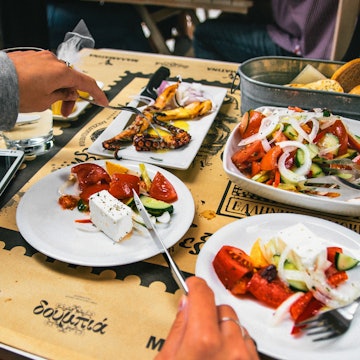

Portes restaurant in Hania, Crete. Image by Vassil Tzvetanov / CC BY 2.0
Where to eat and drink in Greece? Perhaps the question should be: ‘Where not?’ Greeks live to eat and drink – they dream about it and talk about it at all times of the day. Wherever you go in Greece you might not find accurate clocks, punctual flights or a good cup of tea, but by Zeus you’ll find sustenance!

Suvlatzidhiko
Greece’s original fast food can be found at any of the nation’s suvlatzidhiko. These are easily spotted by the joint of meat being grilled on a spit at the front of the shop. Yiros (carved spit-roast meat served in pita with salad and tzatziki) is traditionally eaten standing, or walking, or at any rate outdoors. But because tourists are so taken with yiros, many restaurants carry it on the menu.
Be careful when ordering yiros or suvlaki (skewered and chargrilled cubes of meat) in a proper sit-down restaurant. If you want that tasty bread-and-meat bundle, be sure to ask for me pita (with bread). Restaurants can’t charge you much for this humble fare, and in order to jack up the price many establishments will assume that you desire a full-plate meal. Not only will you get a stiff bill, but you’ll be wasting a lot – we have never seen anybody polish off an entire suvlaki plate.
Taverna
The traditional, quintessential public eating house of Greece is the taverna. This is Zorba the Greek, Henry Miller and Lawrence Durrell type dining. It’s what amounts to an extension of the Greek home table, offered forth to the community. Indeed, it is believed that this is the origin of the taverna.
There had always been inns in Greece. Since ancient times private homes along the road opened their doors to the passing public. There the traveller could get a simple meal, a bed and a bed companion. It was not until the late Byzantine era that the inn began to lose its association with the brothel and slowly acquire a reputation as a place where quality cooking was the chief attraction.
Furnos
Quite possibly the most common sort of food vendor you’ll see in Greece is the pie shop, selling such favourites as tiropita (cheese pie) and spanakopita (spinach pie). No matter where a Greek works there will be a pie shop along the way, and here the hungry commuter may pop in for a nibble to take on the way to work.
If you love pies you’ll be in heaven here; if you hate pies you’ll be in hell. In every city in Greece at any time of day or night you’ll see people walking down the street eating pies. Even if you don’t see them you can find them as the filo dough used to make most pies is so flaky that all pie eaters leave flurries of flakes in their wakes.
Kreperi
This place is popular with university students, artists and bohemian types. The fare is simple but tasty: savoury and sweet crepes, usually made by a crepe cook working in a window like a pizza tosser. The most common savouries are cheese with mushrooms, and the sweets are limited only by imagination.
As with any Greek gastronomic venue this is a place for talk as much as a place for food. People will spend half an evening in a creperie, and they might not even have a crepe. Perhaps they will simply order a bottle of wine, or even a series of cocktails, as they usually have a full bar.
Ouzeri
The origin of the ouzeri is in the private home. During the late Ottoman time householders were at liberty to make their own spirits. Then the doors could be opened and anyone with a drachma could come in for a glass. To provide the necessary solid absorption material, the house cook made little dainties; these became many of the mezedhes that we know today. The ouzeri itself became a place where both the libidinous Greek and the abstemious Turk could meet for drinks and a snack. Often they would bring along their musical instruments and have a jam session; they would play backgammon or dominoes, smoke hookah pipes and tell stories.
The service and fare eventually became somewhat codified; the traditional order is for a plate of mezedhes and a quarter-litre of ouzo (the alcoholic equivalent of a bottle of wine). In recent decades ouzeris have been expanding on their offerings and some of them offer a proper meal. Some even have wine, beer and coffee. They are tavernas in all but name and have lost their link with the past – and of course tavernas now sell ouzo.
Estiatorio
This is the Greek word for restaurant. It’s a recent innovation in the Greek culinary scene. How does it differ from the taverna? Sometimes it’s hard to say. The easiest way to tell the difference is by what’s covering the table. If it’s paper it’s a taverna, if it’s cloth it’s an estiatorio. But is that the only difference?
Well, sometimes it is, if the board of fare is Greek. If it’s foreign viands they offer, it will almost always be called an estiatorio, paper, cloth or otherwise. But the chief difference between tavernas and estiatorio for the traveller is that you will pay more for the same dish in an estiatorio – and the waiter will expect a generous tip.
Kafenion
One of the oldest gastronomic institutions in Greece and a product of the Ottoman occupation, kafenion is the original coffee shop. You’ll see them everywhere, and you may wonder why they exist. Their decor is, well, non-existent: suburban garage has more to commend itself to the eye. Traditionally kafenia serve Greek coffee and little else, and traditionally only men above a certain age patronise them. They are full of tobacco smoke. And yet they, the men and the kafenia, refuse to die.
This is because they are undemanding places. One may go to the kafenion and play checkers with friends, or simply sit alone with one’s thoughts. You can strike up a conversation, or be left alone. Nowadays you may have beer or ouzo, as well as gritty Greek coffee. Women may go to the kafenion – there was never any law prohibiting it. But while in the past women simply would not care to be seen there, nowadays we see them chatting, smoking, having a cuppa. The kafenion is so undemanding, so relaxed, that it is an island of respite in an increasingly demanding world.
Roofless restaurant
The weather is fine in most of Greece most of the year, and this has given rise to what we call the roofless restaurant. It is usually of the taverna type, though operated by younger, artistic sorts who want to push the envelope without punching through it. All over Greece there are buildings with roofs that have fallen in, mostly due to age but also to earthquakes and even wartime bombing. The still-standing walls provide protection from chilly breezes, yet the sky is yours for the gazing.
Kafeteria
This is the place for hot and cold drinks, mid-morning snacks, toasted sandwiches, omelettes and ice creams. Unlike a snack bar, you are expected to sit at a table, rather than have a take-away meal. Cafeterias are usually located around the main square or along the harbourfront.
Nihterino kendro
This is where Greeks have a night out: dine, smash plates and dance to live music. They can be expensive, depending on the calibre of the artists they attract. Watch for richly bejewelled men setting fire to banknotes to show their largesse.
Zaharoplastio
A zacharoplastio provides tables where you can sit and enjoy a piece of cake and coffee. This is where you’ll find Greeks in the late afternoon, especially on summer evenings.















